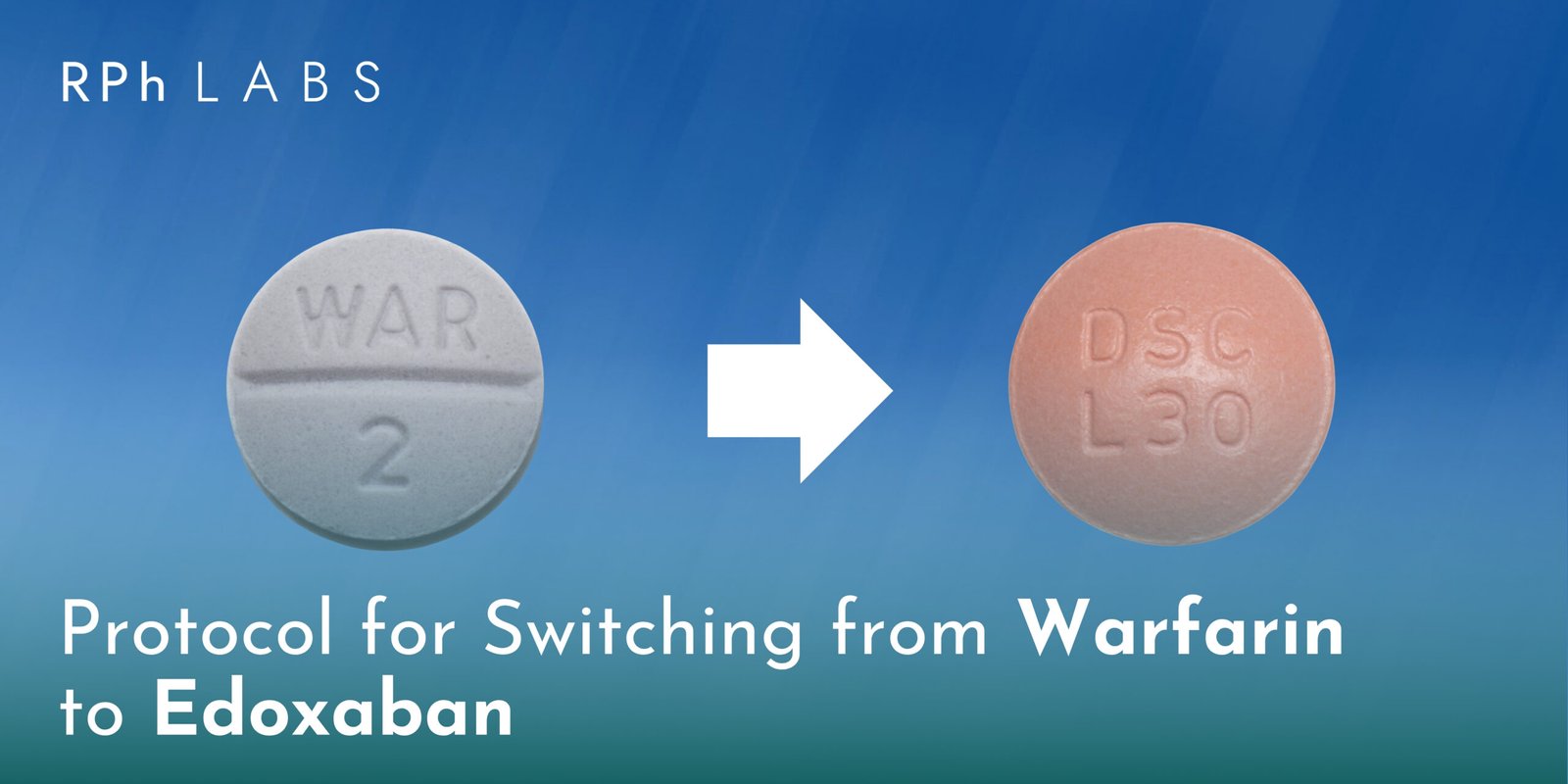
Protocol for Switching from Warfarin to Edoxaban
Whether you’re about to start a new medication, or only switching from one to another, knowing how your body may react to certain medications can help you save from the trials and errors. Trial and error is a problem-solving method that involves trying different solutions until one works. Trial and error is a problem-solving method that involves trying different solutions until one works, thus, in medicine this means administering a medicine and advising patients to come back in case of any unwanted effects. Humans can be divided into poor metabolizers, intermediate metabolizers, extensive metabolizers, and ultra-rapid metabolizers – drugs consumed are metabolized in our bodies at different rates accordingly. Both Warfarin (Coumadin) and Edoxaban (Savaysa) are anticoagulants (a broad class of medications that prevent blood clots) requiring careful dose adjustments based on individual factors. Therefore, understanding an individual’s metabolizer status is a crucial element for both, the best Warfarin dosing and protocol for switching from Warfarin to Edoxaban.
This image is only provided for reference.
INR Test- An Important Protocol for Switching from Warfarin to Edoxaban
International normalized ratio (INR) is a blood test that measures how well your blood clots. It’s a standardized number that’s calculated from the results of a prothrombin time (PT) test. An INR value of 1.1 or lesser is considered normal range. According to Gloshospitals, “Stop Warfarin and start Edoxaban as soon as INR ≤2.5.”
In-Depth Guide on Coagulants – Warfarin and Edoxaban:
Switching between anticoagulants like Warfarin and Edoxaban requires a systematic approach to avoid complications such as bleeding or thromboembolic events. Both drugs are anticoagulants, but their mechanisms of action, monitoring requirements, and pharmacokinetic profiles differ significantly, making the transition process highly individualized.
Warfarin vs. Edoxaban: Mechanisms of Action
| Feature | Warfarin | Edoxaban |
|---|---|---|
| Mechanism | Vitamin K antagonist. Inhibits clotting factors II, VII, IX, and X. | Direct Factor Xa inhibitor. Prevents thrombin formation. |
| Onset | Slow (2-5 days to achieve full effect). | Rapid (1-2 hours after administration). |
| Monitoring | INR monitoring is required regularly. | No routine coagulation monitoring is required. |
| Dietary Effects | Affected by dietary vitamin K (e.g., green leafy vegetables). | Minimal impact from diet. |
Anticoagulation and the Role of INR in Switching
For patients switching from Warfarin to Edoxaban, maintaining safe INR levels is critical to avoid clotting or bleeding risks. Warfarin has a narrow therapeutic index, requiring close INR monitoring, whereas Edoxaban’s fixed dosing eliminates this requirement. Transitioning involves waiting for the INR to drop to ≤2.5, as a higher INR poses a bleeding risk when initiating Edoxaban.
Pharmacokinetics and Genetic Considerations
Warfarin’s metabolism is influenced by genetic variations in the CYP2C9 and VKORC1 enzymes, which explain the variability in dosing requirements among individuals. Edoxaban, in contrast, undergoes minimal hepatic metabolism, with P-glycoprotein playing a role in its clearance. The shift from Warfarin to Edoxaban thus simplifies dosing but requires consideration of kidney function, as Edoxaban is primarily renally excreted.
Did you know?
Pharmacogenomics testing (PGx testing) from RPh LABS offers insights into your DNA, allowing doctors to prescribe drugs and doses according to your genetic makeup.
Practical Protocol for Transition
1. Evaluate Current INR
- Check the INR before stopping Warfarin. The ideal value for starting Edoxaban is ≤2.5.
- If INR is >2.5, delay the initiation of Edoxaban until INR falls within the target range.
2. Discontinue Warfarin
- Stop Warfarin completely. Do not overlap with Edoxaban due to the increased risk of bleeding.
3. Initiate Edoxaban
- Begin Edoxaban at the prescribed dose (usually 60 mg once daily for most patients).
- For patients with renal impairment (CrCl 15-50 mL/min), a reduced dose of 30 mg is recommended.
4. Monitor for Adverse Events
- No routine coagulation tests are needed for Edoxaban, but patients should be monitored clinically for signs of bleeding or thromboembolism.
Clinical Pearls: Why Switching Matters
- Patient Safety: Warfarin’s unpredictable interactions (e.g., dietary and drug-drug) increase the risk of complications. Edoxaban provides more consistent anticoagulation.
- Convenience: Edoxaban’s fixed dosing and lack of regular monitoring improve patient adherence and quality of life.
- Special Populations: In patients with poor compliance or dietary restrictions, Edoxaban offers significant advantages over Warfarin.
Common Challenges in Transitioning
- Bleeding Risk: Initiating Edoxaban before INR is ≤2.5 can lead to major bleeding.
- Thromboembolism: Delaying Edoxaban initiation after stopping Warfarin can create a gap in anticoagulation coverage.
Conclusion
Switching from Warfarin to Edoxaban offers several advantages, including simplified dosing and reduced monitoring. However, the transition should be carefully managed, with a focus on INR values and individual patient factors such as renal function and genetic predispositions. Adopting pharmacogenomic testing can further enhance safety by tailoring anticoagulation therapy to a patient’s genetic makeup. See more on how a PGx test (pharmacogenomics test) works here.
References:
https://accesspharmacy.mhmedical.com/book.aspx?bookID=3191#266698676
https://www.gloshospitals.nhs.uk/media/documents/Guidance_on_converting_between_anticoagulant_regimens.pdf
Disclaimer: This blog is only for informational purposes. Always consult your healthcare specialist before taking any medical action.



Leave a Reply